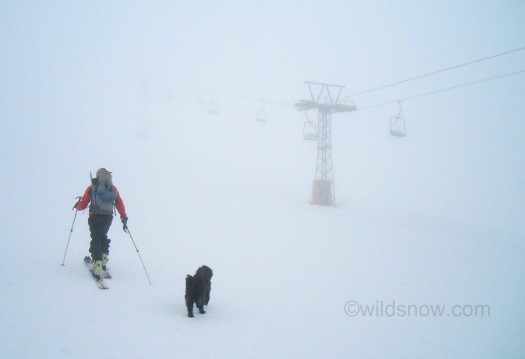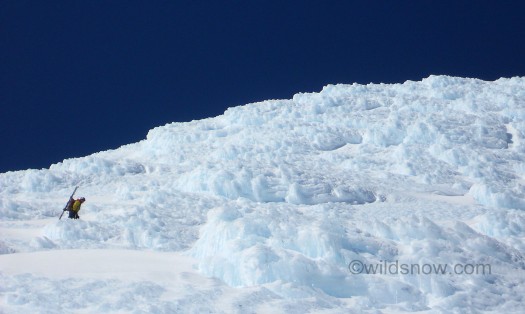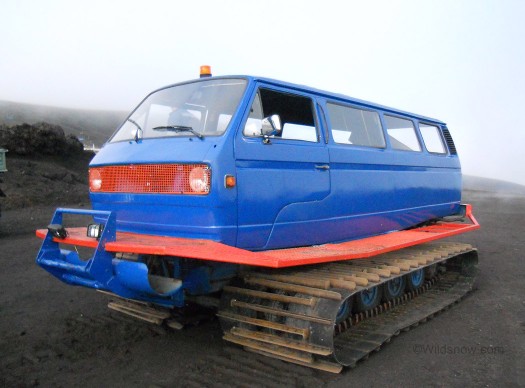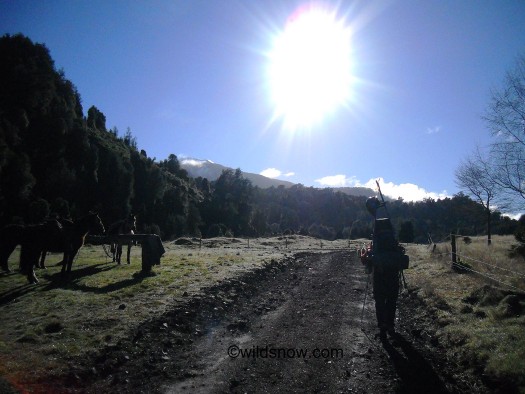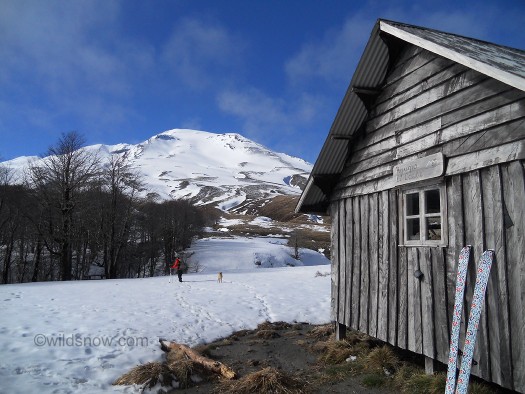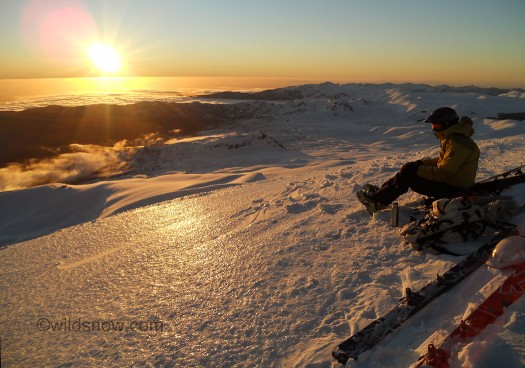
Cold and beautiful, sunset on Volcan Puyehue. That's not the ocean, it's haze made by wood fire smoke.
I haven´t had access to much internet recently, so the my trip reports from South America are a little behind. To sum it up, it´s been full on volcano season. We tried to ski every lava filled rock we could see, and didn´t do a half bad job. The final count stands at a nice even ten: Volcan Chillan Nuevo, Chillan Viejo, Nevados de Chillan, Villarica, Tronador, Lanin, Osorno, Puyehue, Llaima, and Lonquimay. Whew!
I´ll start off with Osorno. After skiing Lanin, we part ways with Sanders, who began his journey back to Holland. Our volcanic appetite thoroughly whetted, we return to Chile, and bus to Puerto Varas, in the heart of the Lake District, surrounded by lakes, of course, and volcanoes. Our lack of a car, as well as many volcanoes lack of snow, makes our choice easy. We decide to ski Volcan Osorno, a tall volcano with a ski area on the lower slopes, facilitating access.
The day after arriving in Puerto Varas, we catch a bus most of the way to the ski area, and then attempt to hitch. The first ride comes quick, but we wait for the second for over an hour. Eventually we reach the ski area, and find the reason for our troubles. There are only a couple cars in the parking lot, and employees outnumber the skiers on the mountain. It´s easy to see why, as the lower ski area consists of barren, steaming pumice gravel, and the upper portion is obscured by clouds. We decide to skin up one of the narrow tongues of snow, and see how far we can get, a strategy that´s served me well in the past.
Alas, today it is not to be. We reach the top of the upper lift quickly enough, but rarely get a glimpse out of the thick clouds, and our hitchhiking has eaten up time. It is now three o’clock. We eat a long lunch, and head down, in order to have some time to find a ride. After another long wait, a Chilean family took pity on us, and took us all the way back to town.
We self-prescribe empanadas for recuperation, and decide to try again the next day. With the bus routes dialed, we are able to get going earlier. After more desolate hitchhiking, we arrive at the ski area. A marked change from the day before, the sun is shinning in a cloudless sky, and the ski area customers had doubled to approximately six.
We skin up the slopes once again, and the weather holds. The snow becomes icier as we rise above the high point of the day before. I switch between crampons and skins a few times. Without anything to use for scale, it’s hard to tell what size the cone in front of us is, or what the skiing will be like. One minute it looks like fifteen minutes to the top, and after thirty minutes of walking, it looks the same.
As we near the top, the smooth, icy snow transforms into hummocks of rime. After noticing a hail of ice issuing from Skyler’s crampons above me, I opt for a slightly different route. The cramponing proves difficult, the bulgy, steep rime is to hard to plunge the shaft of my axe, and rarely affords a solid pick placement. With a new-found respect for the rime bulges found on many of the alpine climbs of Patagonia, we arrive at the summit.
The summit is free of winds, a rare treat for a volcano. However when we look over the steeper northern side, it’s like sticking your head out of a speeding car. We envy the steeper, sun softened snow on the north side (the fact that it was snow would have been sufficient). Thousands of feet below, the corn terminates in lava fields and thick undergrowth. If we make it through that, we’ll end up on the desolate shore of a remote, massive lake. Common sense wins, and we turn to make our way down our ascent route. We skitter over the low angled rime of the summit, an experience akin to wearing skis in a boulder field. When the angle increases, we switch to crampons, and make our way to where the rime bulges diminish in size. The skiing starts out on smaller versions of what we down-climb through, and eventually we make it to better snow. Not exactly corn, but sun softened rime skis surprisingly well. The sun low in the sky reflects off numerous lakes, some tiny, some so big we couldn’t see the other side. The stunningly beautiful view reminds me of skiing down the west ridge of Denali.
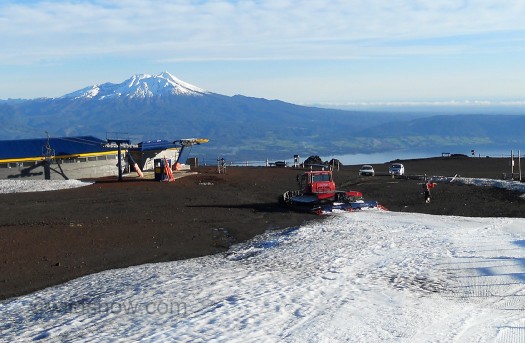
Osorno ski area is hurting for snow. When we depart in the morning, they had plowed a strip of snow to the lift. By the time we returned, it had melted away.
We arrive at the base of the ski area after most of the customers had left, however we are able to get a ride with some employees. They pull up with a pickup loaded with trash, and we hop on top of the pile. The road to the ski area is curvy, and the ski patrolmen drive it like they were in a Gymkhama race. After a terrifying half an hour of squealing around corners and passing tour buses like they were standing still, clinging to the trash pile like ticks, we make it safely to the main road. We quickly catch a bus into town.
Our adventures for the day are far from over. Early on in the trip my shoes got stolen, so I buy a cheap pair of snow boots at the nearest store. They work well enough, but dodn’t breathe at all. For the remainder of the trip, my unhappy feet aere either stuffed into ski boots, or immediately transferred to the snow boots, a slight improvement. Needless to say, the level of foot abuse rose above even my normal regimen of way too many days spent in ski boots or climbing shoes. Willing to live with slightly more stinky feet, I ignore their cries for help until that day on Osorno.
Throughout the day, my feet have an uncomfortable tingling sensation, which grows unbearable by the end. When I finally take my boots off, parts of my feet have turned a sickly white, and lost feeling. I leave my boots off for our trash pile ride, and they are unbearable to put on again, so I simply board the bus with bare feet. What had seemed like an empty bus immediately starts filling up, both with people, and with an awful stench.
After a few minutes, I put my boots back on, painful as it is, but the damage is done. People in the front of the bus start groaning, and a little kid standing next to me can’t stop giggling. Open windows and someone’s air-freshener does little to help. Some people find it hilarious, but most do not. It is an uncomfortable hour long bus ride, to say the least.
When we get into town, I go on a mission to buy foot powder and some normal shoes. That and a day spent hanging out barefoot seem to put my feet back to normal. An internet search point to a mild case of immersion foot.
The next day, we take a bus to the trailhead for Volcan Puyehue. I’d first heard about Puyehue in the ski movie All.I.Can. It’s unique, possessing a huge, mile wide crater, with some beautiful runs leading into it. In the movie they mention that the volcano erupted, and “that place that we were, is now gone.” Consequently I didn’t have high hopes of skiing Puyehue. I was happy to later learn that the eruption occurred in a separate crater, and the summit is still intact.
We spend a day traveling, and camp at the trailhead, or more accurately, a farm. In the morning we hike through cow pastures, and three ranch dogs decide to follow us. After a few hours we make it to a refugio situated at snowline.
The hike is brutally steep, but only takes a few hours. We still have the entire afternoon. After a few hours of napping and hanging out, we decide to head up to the summit to scope it out and enjoy the sunset. There is barely enough snow near the hut to start skinning, so we start off, with the three dogs out ahead.
The snow is similar to some of our previous adventures: icy. By piecing together strips of slightly better snow, we are able to stay on our skins for a while. The dogs, however, don’t do as well. After sliding around and tripping over themselves, sometimes hilariously, their enthusiasm starts to wain. Two of them turn around, an ancient wiener dog and a bigger, old guy. The third presses on, and we make it to the summit, after a short bit of booting.
The summit is incredible, not that high, or that steep, but incredible. On one side was the infamous, massive caldera, with steep rock and snow slopes leading into it, orange in the evening light. Below us on the snow-covered plateau, old lava flows fill in valleys and piled on top of one another. Further away, a mass of black, steaming rocks, miles across, can be seen on the other side of a small group of peaks. We feel like hobbits first sighting the gates of Mordor. Last year’s eruption has not only spewed millions of tons of ash into the air, but has also filled an entire valley with lava. I’m no expert, but it still looks pretty hot, at least deep down.
We make the climb quickly, and have a few hours to spare before sunset. I hike around a bit, scoping lines for the next day. It doesn’t look good; all the south facing slopes are devoid of snow, and the other aspects aere coated in ice, reflecting the orange light. We sit and enjoy the sunset, while the dog shivers and regretts following us. Wood heat is the favorite in Chile, and the resulting haze in the valleys makes for incredible sunsets. After the Oscar-worthy show is over, we make our way down the slopes back to the warmth of the refugio. Skyler skis the iciest bit with the squirming dog held tight in his arms.
The next morning we lock the dog in the hut, and decide to head over to the fresh lava flow, then loop back to the top to ski the ice-protected crater. We make our way over rolling terrain, and cover ground fast. One (the only?) benefit of bulletproof snow is how fast and far you can glide. Eventually we roll up to the bare lava, a wall rising a hundred feet out of the ground like some ancient castle wall. We leav our skis and started exploring. Walking over rocks created a year ago is surreal. Some are sharp enough to slice gloves like a razor, while others crumblee with the kick of a ski boot. Steam rise everywhere, some of it too hot to touch. Far on the other side of the expanse steam rises in a continuous, massive sheet. We wonder if it meant exposed lava. Making it that far is out of the question, the mile or so would take hours, maybe all day. The rocks are unstable, and the way is blocked by hundreds of tiny canyons, spires, and spewing steam.
We return to our skis, and turn our attention to the caldera. After a few hours of hiking up perfect corn, we make it to the rim, and find perfect ice. We have to ski the crater, so we find what looked to be the softest spot, and drop in. I barely stop my skis on the first turn, and most of the others. The run is longer than it looks, and ending in the deep crater makes it amazing. After a short boot out of the other side, we arrive in time to enjoy another amazing sunset, and ski corn down to the refugio.
The next day we slepe in, and hike the brutal downhill trail back to the trailhead. Parts of the trail are eroded into mud-canyons, some over 10 feet deep and barely big enough to squeeze through. Most of the time we opt to bushwhack through ash coated trees instead, coating ourselves in the process. The hike is tough, but short, and we make it back in time to catch a bus. We head north, eager to find more of the corn we tasted the evening before.
It’s an odd fact that many of my favorite ski trips have been days with horrible conditions. Exploration and adventure are really what I love about ski mountaineering. I stood on fresh lava, skinned across a crater bigger than my neighborhood, and watched the sunset from the top. That’s something I’ll remember for a long time. The snow on Puyehue was undeniably awful, but I wouldn’t trade the experience for any pow day.
View -40.582410, -72.117056 in a larger map
Zoom out to see where we were.
Louie Dawson earned his Bachelor Degree in Industrial Design from Western Washington University in 2014. When he’s not skiing Mount Baker or somewhere equally as snowy, he’s thinking about new products to make ski mountaineering more fun and safe.

